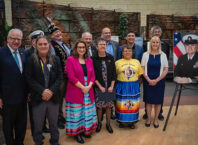
By AP
U.S. Interior Secretary Deb Haaland says her agency will work to restore more large bison herds to Native American lands under an order that calls for the government to tap into Indigenous knowledge in its efforts to conserve the burly animals that are an icon of the American West.
Haaland was expected to announce a secretarial order meant to help more tribes establish bison herds, along with $25 million in federal spending for such efforts. The Associated Press obtained details on the order in advance.
The money, from last year’s climate bill, will build new herds, transfer more bison from federal to tribal lands and forge new bison management agreements with tribes, officials said.
Bison have bounced back from their near extinction due to commercial hunting in the 1800s. But they remain absent from most of the grasslands they once occupied, and many tribes have struggled to reforge their deep historical connections to the animals.
As many as 60 million bison once roamed North America, moving in vast herds that were central to the culture and survival of numerous Native
American groups.
The animals are “inextricably inter-
twined with Indigenous culture, grassland ecology and American history,” Haaland said in a statement.
They were driven to the brink of extinction more than a century ago when hunters, U.S. troops and tourists shot them by the thousands to feed a growing commercial market that used bison parts in machinery, fertilizer and clothing. By 1889, only a few hundred bison remained.
Haaland said the bison’s slow recovery has been a conservation success, yet more work is needed to return the animals to tribal lands and restore the grass- lands they depend on. Haaland, of Laguna Pueblo in New Mexico, is the first Native American to serve as a U.S. Cabinet secretary.
Across the U.S., from New York to Oklahoma to Alaska, 82 tribes now have more than 20,000 bison in 65 herds. Numbers have been growing in recent years along with the desire among Native Americans to reclaim steward- ship of the animals.
Many of the tribes’ bison came from U.S. agencies, which over the past two decades transferred thousands of the animals to thin government-controlled herds so they don’t outgrow the land.
Past administrations have proposed or advanced bison conservation plans – including under former Presidents George W. Bush, Barack Obama and Donald Trump – and tribes have long been part of that process.
Haaland’s order puts Native American interests at the center of the Interior Department’s bison program. It also adds a tribal leader, yet to be named, to a group
that’s exploring establishing new herds on both tribal and federal lands.
Those actions could put the Biden administration at odds with state offi- cials in Montana who have resisted more bison on federal lands and some previous bison transfers to tribes. State law-makers voted in late March to advance a resolution opposing the reintroduction of bison to the million-acre (400,000- hectare) Charles M. Russell National Wildlife Refuge in northern Montana – an idea that’s been floated by the Biden administration.
About half of the $25 million will go to the National Park Service. The remainder will be split among the Bureau of Indian Affairs, the Bureau of Land Management and the Fish and Wildlife Service.
It includes about $1 million to establish an apprenticeship program that will provide training to tribes on managing bison, including at national parks and national wildlife refuges, officials said.
The Interior Department currently oversees 11,000 bison in herds on public lands in 12 states.
The announcement from Haaland was planned for a commemorating World Wildlife Day at the National Geographic Society in Washington, D.C.






